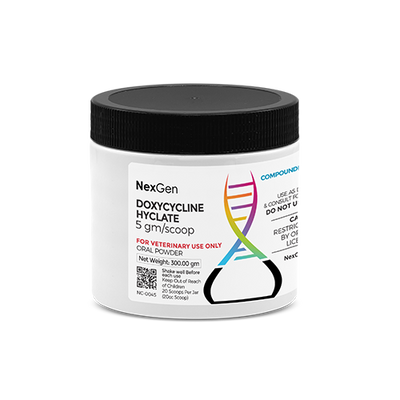
Methocarbamol 5 gm/scoop, Oral Powder, 100 Scoops (20cc Scoop)
Login for pricing
- Brand
- Mixlab
- SKU:
- NC-0269
- Product Type:
- Powder
- Size:
- 64oz
- Administration:
- Oral
- Scoops Per Container:
- 100
- Scoop Size:
- 20cc
Recurrent muscle pain and stiffness with exercise occurs in many breeds of horses. The terms Monday Morning Disease, Azoturia, tying-up, chronic intermittent rhabdomyolysis and recurrent exertional rhabdomyolysis (ER or RER) have all been used to describe this syndrome. Numerous causes for these have been proposed over the years, including hypothyroidism, electrolyte depletion, lactic acidosis, glycogen storage disorders and altered muscle contractility.1 In most cases, the entire collection of symptoms is typically referenced as exertional rhabdomyolysis (ER) whether it is recurrent or sporadic.
Thoroughbred horses are particularly susceptible to ER, with 5-10 % of all Thoroughbreds developing ER during a racing season.2 There is strong evidence from studies that susceptibility to ER has an underlying genetic basis; however the genetic model and pattern of inheritance has not yet been conclusively defined.3
Symptoms of ER in the Horse
Symptoms of exertional rhabdomyolysis usually present shortly after horses start to exercise or when resting post-exercise. These include:
- Muscle spasms
- Excessive sweating
- Rapid heart beat
- Rapid breathing
- Refusal to move
- Painful, firm muscles in the low back and rump
- Discolored urine
Sporadic Exertional Rhabdomyolysis
Horses of any age or breed can develop sporadic ER. Common causes include overexertion, muscle trauma, nutritional or electrolyte imbalances and fatigue. It has been reported that horses participating in endurance competitions on hot, humid days are more susceptible to sporadic ER due to high body temperatures, insufficient fluids and electrolytes and depleted energy stores. For the management of horses with sporadic ER, equine veterinarians often recommend rest, fresh water and tranquilizers or NSAIDS. Supplementing a horse’s diet with sodium, selenium and vitamin E is also helpful.3
Recurrent Exertional Rhabdomyolysis
There is anecdotal evidence that horses with nervous personalities experience more episodes of recurrent or chronic ER, although it is far more common in Thoroughbreds and Quarter Horses.3 Stress seems to induce the condition in certain instances. In addition to an assessment by an equine veterinarian, a balanced diet and an adequate intake of minerals and vitamins are helpful in managing recurrent ER.1
NOTE: The Association of Racing Commissioners International Uniform Classification Guidelines for Foreign Substances has designated methocarbamol a CLASS 4 DRUG.
Where to buy Methocarbamol
Methocarbamol is available in the U.S. through several pharmaceutical manufacturers and through veterinary custom compounding companies.
Methocarbamol carries several potential drug interactions. Please consult your veterinarian prior to beginning any treatment regimen.
FOR RX ONLY: A valid prescription from a licensed veterinarian is required for dispensing this medication.
1Valberg, S., et. al. Exertional rhabdomyolysis in Quarter Horses and Thoroughbreds: one syndrome, multiple aetiologies. Equine Exercise Physiology 5 Equine vet. J., Suppl. 30 (1999) 533-538.
2Fritz, K.L., et. al. (2012), Genetic mapping of recurrent exertional rhabdomyolysis in a population of North American Thoroughbreds. Animal Genetics, 43: 730–738.
3msu.edu.














